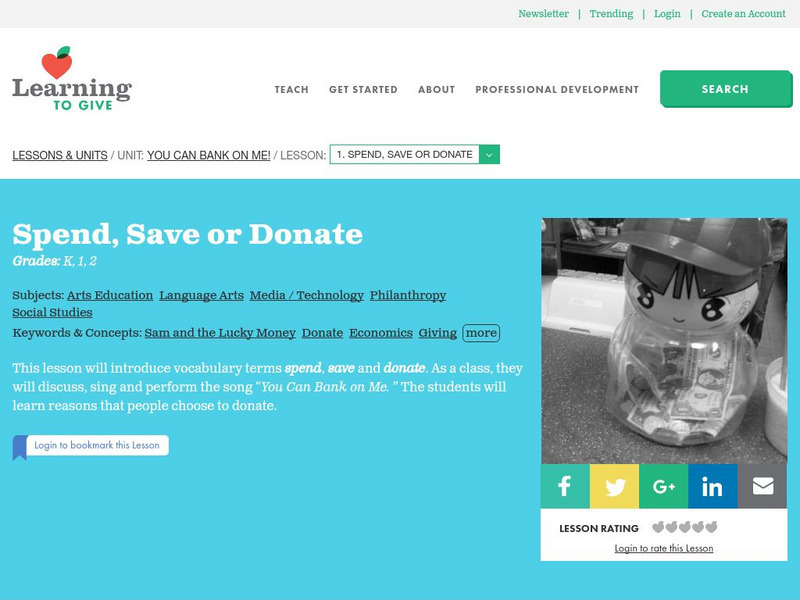Hi, what do you want to do?
Organization for Community Networks
Academy Curricular Exchange: Consumer Borrowing and Saving
A lesson plan which has students learning the realities of borrowing and saving money.
Council for Economic Education
Econ Ed Link: Buy a Bond, James: A Lesson on Us Savings Bonds
This site is extremely informative for teaching children the value of saving money. "You will write a persuasive letter telling why people use savings bonds as a way to save their money."
Illustrative Mathematics
Illustrative Mathematics: Saving Money 2
The purpose of this task is for students to relate addition and subtraction problems to money and to situations and goals related to saving money. A problem is given that will contain multiple solutions, this allows students to think...
Scholastic
Scholastic: Adventures in Math: Lesson 1: Saving Money for Your Future
Tips for learning the value of saving money to achieve your financial goals.
Consumer Financial Protection Bureau
Consumer Financial Protection Bureau: Evaluating Savings Scenarios
By analyzing real-world scenarios, students practice making informed decisions about savings tools to meet financial situations and needs. Includes teaching guide, a handout on options for saving money, and a student worksheet that can...
Council for Economic Education
Econ Ed Link: A Penny Saved Is a Penny at 4.7% Earned
This is a instructional activity from EconEdLink where students learn about saving money. Includes activities and materials.
Practical Money Skills
Practical Money Skills: Lesson Two: Spending Plans
This lesson introduces children to the concept of dividing their money into categories, namely "save," "spend," and "share" and presents activities that will help them understand that money is limited in quantity and must be divided for...
Consumer Financial Protection Bureau
Consumer Financial Protection Bureau: Saving Each Payday
Students use a real-world simulation to learn how saving a little money each payday can be a successful strategy for saving. Includes teaching guide and student worksheet that can be filled in on a computer.
Consumer Financial Protection Bureau
Consumer Financial Protection Bureau: Exploring Savings Habits
Students learn about the benefits of forming their own savings habits and explore what it looks like to save a percentage of income.
Scholastic
Scholastic: Adventures in Math: Lesson 2: Money Planning
What can we do with money? Deciding on the best use of our money requires planning. Students will identify ways that money can be used: spending, saving, and giving.
Practical Money Skills
Visa: Practical Money Skills: Lesson Plans for Grades 7 8
Fourteen financial literacy lesson plans for middle school students cover topics such as budgeting, living on your own, the influence of advertising, and saving and investing.
Practical Money Skills
Practical Money Skills: Lessons: Grades 3 6
Four fiancial literacy lessons on allowances, money responsibility, saving, and comparison shopping. Lessons can be evaluated separately or as a group.
University of Nebraska Omaha
University of Omaha: Why We Save [Pdf]
Why do people need to save money? This lesson plan is geared for Kindergarten through 2nd grade and helps pupils understand the reasons for saving.
Council for Economic Education
Econ Ed Link: Climbing the Savings Mountain
Students discover how saving money can be compared to a mountain climb. The climb can be fast or slow, safe or hazardous, scenic or thrilling. You will find out that there is more than one way to get to the top!
Consumer Financial Protection Bureau
Consumer Financial Protection Bureau: Saving for Post Secondary Education
Students use an online compound interest calculator to answer questions and create charts that show the value of saving money over time for future education goals.
Illustrative Mathematics
Illustrative Mathematics: 2.nbt Saving Money 1
In this lesson plan students use strategies based on place value to add and subtract within 100.
Scholastic
Scholastic: Adventures in Math: Lesson 2: Saving Money by Finding the Better Buy
Students will be able to make economically sound purchasing decisions by using unit pricing, calculating discounts, and analyzing fixed and variable costs.
Better Lesson
Better Lesson: Loans and Savings
What are loans and how do they work? How do banks encourage people to save money? Students work on these questions in the context of the College Project.
Learning to Give
Learning to Give: Spend, Save or Donate
This lesson will introduce vocabulary terms spend, save and donate. As a class, they will discuss, sing and perform the song "You Can Bank on Me. " The students will learn reasons that people choose to donate.
Federal Reserve Bank
Federal Reserve Bank of St. Louis: Less Than Zero [Pdf]
This lesson accompanies a story by Stuart J. Murphy called Less Than Zero and teaches students about how to manage their money by saving it and setting goals for themselves.
Other
Finra Investor Education Foundation: Introduction to Earning Interest 11 & 12
Students will know and be able to use the formula for calculating compound interest and understand the effect of compounding on savings in this lesson.
Practical Money Skills
Practical Money Skills: Lessons: College
Ten financial literacy lesson plans allow college students to build on their skills and cover topics such as budgeting, living on your own, managing credit cards, cars and loans, and saving and investing.
Practical Money Skills
Practical Money Skills: Lessons: Special Needs
Ten customizable financial lessons designed for special needs students.
Other popular searches
- Spending and Saving Money
- Saving Money Activities
- Earning and Saving Money
- People Saving Money
- Saving Money Lessons
- Saving Money for Kids
- Saving Money Games
- Budgeting and Saving Money
- Saving Money Interest
- Saving Money for Vacation
- Saving Money Teens
- Saving Money Strategies











